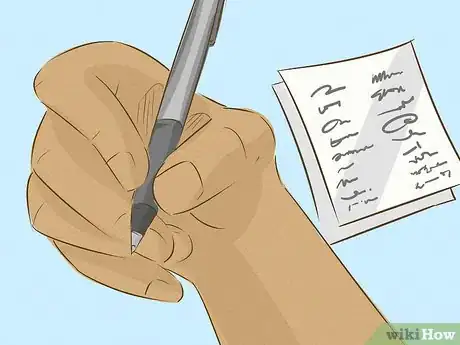This article was co-authored by Richard Casamento. Richard Casamento is a Digital Business Development Specialist and the owner of the WIN Marketing Group, a digital marketing consultancy based in northern New Jersey. With over ten years of experience in marketing and over 25 in electrical engineering, he specializes in content marketing, Search Engine Optimization (SEO), paid media advertising, television, and social media operations. He has grown the WIN Marketing Group to serve a diverse group of clients who benefit from a highly analytical and personal approach to marketing. Richard holds a BS in Electrical and Computer Engineering from The University of New Hampshire and a Certificate of Study in Lasers and Optical Engineering from Stevens Institute of Technology.
wikiHow marks an article as reader-approved once it receives enough positive feedback. This article received 11 testimonials and 84% of readers who voted found it helpful, earning it our reader-approved status.
This article has been viewed 513,630 times.
Starting a political party is a major undertaking, and you’ll need lots of support. Figure out your party’s platform at the early stages, then work to get that message out there through events, social media, and word of mouth. When you have enough members, you can set up the organizational structure of your party. If you meet eligibility requirements, like having enough signatures of support and showing proof that you are organized and active as a party, you can officially register with the electoral commission in your area. Then, your party can really get going by fully taking part in elections and political life.
Steps
Organizing Supporters
-
1Hold meetings to generate interest in forming a party. At every stage of creating and maintaining a political party, you’ll need lots of enthusiastic involvement. Let others know that you are interested in starting a new party, and ask them to get involved.[1]
- You could try starting out by holding a meeting with people you already know in a community center or even at your home. If there’s interest in creating a new party, tell them to spread the word to people they know. Hold a second, larger meeting inviting these people, too.
- Ensure attendance at all meetings. When officially filing your party, you’ll typically need to prove that you’ve been holding meetings.
- It’s never too early to start soliciting donations. At the early stages, you can start a crowdfunding campaign. Later, you can have your financial team set up a more formal donation process.
-
2Rally around potential candidates. You might want to start a political party to draw attention to a great candidate for office, and to help them get elected. If you have a charismatic candidate you would like to promote, ask them to attend your meetings. They can give speeches, take promotional photos, greet constituents, and generally increase the buzz about the formation of your new party.Advertisement
-
3Write a platform describing your party’s basic principles. You can start by having discussions at your meetings about what your party wants to emphasize. Generate a list of your principles, and designate a member or a committee to draw these up. Share them with the whole group, make any necessary changes, and vote to officially adopt the platform. Address things like:
- What aspects of political, social, or economic life would your party like to improve?
- What would your party want to accomplish if elected to office?
- What sets your party apart from others?
- Why would voters want to support your party’s candidates?
-
4Establish rules and regulations for your party. A political party is a complex organization, and hopefully one that will grow over time. To keep things manageable, you’ll need to establish another committee to write bylaws. When they’re drafted, share them with everyone before voting to approve them. You’ll often also need to share these when officially filing. Bylaws will discuss things like:[2]
- Who is the party’s leadership? How will they be elected?
- What committees will be formed?
- How do members vote on important issues?
- How will candidates be chosen?
- How will disagreements be handled?
- When will meetings be held, and what form will they take?
-
5Work out the financial aspects. It takes money to organize a political party and promote candidates for elections. Your party will need rules for how money will come in, who will oversee it, and how it will be used. When officially filing your party, you will probably need to provide a statement of your financial scheme and an explanation of your accounting, so it’s a good idea to write these early. Consider:[3]
- How will donations be generated?
- What account or accounts will money be held in?
- Which committee will be in charge of finances?
- Who will provide your accounting services?
- What guidelines do you want to set for things like how money can be spent on election campaigns?
- What procedures will you have for ensuring financial transparency?
- How will you handle any financial disagreements or investigations?
Branding Your Party
-
1Give your party a distinctive name. A political party will be known everywhere by its name, so give this some thought. You’ll need to select a name that isn’t already taken by another party, and isn’t so similar to another one that the public will get confused.[4]
- Check with your local electoral commission for a list of currently registered political parties.
- Select a name that captures your party’s core values.
- Try to keep the name short -- no more than a couple of words. That way, it will be memorable and easily identifiable.
-
2Create a logo identifying your party. Logos are used everywhere to advertise and identify political parties. They’re typically also required when officially registering a party. Choose one that’s not too complex, but is distinctive.[5]
- For example, if your party emphasizes conservative principles, you could select a logo that contains a traditional symbol of your area.
- If you want to brand your party as an innovator, consider a logo that depicts a modern, contemporary symbol while using traditional colors.
-
3Establish a website with your own domain. It’s vital for a political party to have a website that the public can visit for more information. Purchase a domain name that is closely related to your party’s name. Put the website’s address on promotional materials, and distribute these at meetings. Your website’s content could include things like:
- A copy of your party’s manifesto and core beliefs.
- Biographies and statements from party leaders.
- Information about upcoming events and elections.
- Pages for any candidates that are running in elections.
- A link for information on how to donate.
- Clear and specific calls to action.
-
4Utilize social media to promote your party. Get the word out about any events that are hosted by your political party. You can also create and share promotional videos and images to let the public know what your party is all about. Make sure to post regularly -- you can also share news content and other materials that are relevant to your party’s interests.
- Social media services are vital to generating and maintaining interest in your party. Get out there on Facebook, Twitter, Instagram, Youtube, and any other major social media sites.
- Designate a social media team to oversee this aspect of your party’s activities.
Party Registration
-
1Collect signatures from supporters. To qualify as a political party, you’ll typically need a certain number of signatures. This may simply be a hard number, like 1000, or it may be a certain percentage of voters registered in your area, like 5 percent.[6]
- Pass around a paper or online form that announces it as a petition to create a political party. Have supporters sign.
- If you already have enough members in your party, just collect their signatures. Otherwise, get out there on the street, describe your party to passersby, and ask them to sign in support.
-
2Meet any specific eligibility requirements. These can vary widely depending on the area you live in. In some cases, for instance, you might need to do things like:[7]
- Prove that you have spent more than $1,000 on election campaigns in a year,.
- Show that you have received contributions.
- Have a current politician declare membership.
- Reach a threshold number of official members.
-
3File at the right time. In some cases, you can only register a political party at certain times of the year. For instance, you may not be able to register a new political party shortly before an election. If you aren’t sure of the rules in your area, check with your local electoral commission.
-
4Submit official filing paperwork. You’ll need to contact the electoral commission in your area to determine what paperwork you need to file. Typically, it will involve an official form, and copies of supporting documents like a statement of organization, contact information for officers, necessary signatures, and a financial statement.[8]
- There may also be a filing fee.
- Once you’re officially registered, you should be able to officially have candidates placed on ballots for elections.
Community Q&A
-
QuestionCan I start a party in one state of the USA instead of starting one nationally?
 Community AnswerYes, you can. The requirements for state and national are very similar, although you should still look up the state requirements, to be sure of what is required.
Community AnswerYes, you can. The requirements for state and national are very similar, although you should still look up the state requirements, to be sure of what is required. -
QuestionHow many people are needed to start a political party?
 Community AnswerThe rules vary from country to country, but in theory you can have as many physical party members as you want. In most countries, in order to register as a political party, you need at least one person to be registered as having certain roles within your party. For example, you'll need a financial manager.
Community AnswerThe rules vary from country to country, but in theory you can have as many physical party members as you want. In most countries, in order to register as a political party, you need at least one person to be registered as having certain roles within your party. For example, you'll need a financial manager. -
QuestionWhat does it mean to have a party affiliation?
 Community AnswerIt means that you identify with a political party. For example, if you are democratically affiliated, it means you are part of, or support, the democratic party.
Community AnswerIt means that you identify with a political party. For example, if you are democratically affiliated, it means you are part of, or support, the democratic party.
References
- ↑ http://www.sos.ca.gov/elections/political-parties/political-party-qualification/
- ↑ http://www.citizensinformation.ie/en/government_in_ireland/national_government/houses_of_the_oireachtas/registering_a_political_party.html
- ↑ http://www.electoralcommission.org.uk/__data/assets/pdf_file/0004/107680/intro-registration-rp.pdf
- ↑ http://www.citizensinformation.ie/en/government_in_ireland/national_government/houses_of_the_oireachtas/registering_a_political_party.html
- ↑ http://www.citizensinformation.ie/en/government_in_ireland/national_government/houses_of_the_oireachtas/registering_a_political_party.html
- ↑ http://sos.oregon.gov/elections/Pages/form-political-party.aspx
- ↑ https://transition.fec.gov/ans/answers_party.shtml
- ↑ http://sos.oregon.gov/elections/Documents/SEL198.pdf
About This Article
Starting a political party takes a lot of effort, but you can make it easier on yourself by knowing your local requirements, having a distinct brand, and organizing supporters. Before you take any steps to form your party, contact your local electoral commission and find out their requirements for registering a political party. You’ll likely need to spend a certain amount on election campaigns, receive contributions, and have a sizable number of official members. In addition to knowing your goals, come up with a distinctive name that’s short and reflects your party’s values. Then, you can start social media accounts with this name and start promoting yourself. Once you have a social media presence, promote meetings at local places where people can learn about your political party and become official members. For more advice, including how to establish rules for your party, read on.





-Step-9.webp)




-Step-10.webp)
































































